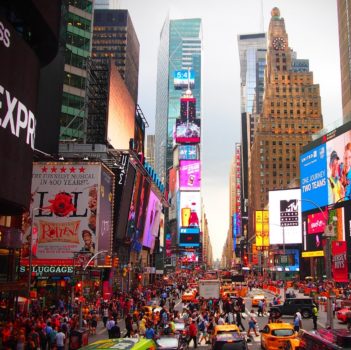Personalised Feed Experience Comes to the Open Web: Q&A with Adam Singolda, Taboola
by on 7th Jun 2017 in News

Viewing advertisements across can be a disorganised experience. Publishers are trying to grow their revenue by selling space, no matter where that space may be, and brands are also trying to find the safest and best environments to advertise, which can lead to lost messaging and increased costs if not addressed. Adam Singolda (pictured below), founder and CEO, Taboola explains how utilising a familiar social feed structure can help solve some of these issues for both publishers and advertisers.
ExchangeWire: What is the new Taboola Feed and why is this exciting to the market?
Adam Singolda: There is a problem with the open web experience as it is today – and mobile in particular feels, at times, as chaotic and disorienting as Times Square signage at night.
It’s filled with too many widgets and ad experiences. Things are coming from the top, pop up in the middle, and overlay the bottom, each with their own user experience (UX) and their own goals –leaving publishers with little real estate on their page, while brands don’t get to choose what experience they’ll be placed next to. Understandably, people read one or perhaps a few articles, and click back to their social feed. In many cases, I can’t blame us all for escaping as fast as we can.
This situation is not sustainable, as the internet is moving rapidly to the limited confines of a 4.5 inch mobile screen.
I believe that publishers should have opportunities to double, or even triple, their revenue and that brands can, in parallel, find scalable and safe environments to invest and grow.
To help accomplish this vision, we asked ourselves: who is doing an amazing job capitalising on mobile today? The answer was obvious – from a UX perspective, social companies are doing a remarkable job. Facebook, Twitter, and Instagram, are rendering 'cards' in a feed-type experience, where Facebook alone gets people to scroll and engage with content for nearly an hour every single day according to the NYTimes.
We essentially wanted to bring that same feed experience to the open web.
What does this mean for publishers?
As of today, in the current widget economy, publishers have to think of themselves as real estate companies –optimising for pixels to drive the highest yield.
Instead, publishers need to embark on the beginning of a new ‘streamlined economy’, rendering information in a consistent experience that’s scrollable and personalised so that people see the cards and information they want to see. It’s about publishers winning people’s attention, getting them to stick around, read more of the publisher’s content, watch videos, and help monetise the quality stories publishers work so hard to write. The goal over time should not be incremental, but a revolution in terms of monetisation and engagement growth.
The New York Daily News was the first to beta test Taboola Feed on both mobile and desktop pages, and they’ve seen fantastic results – an uplift in revenue of 26%, and engagement of 40% on mobile.
“User behaviour evolves as digital environments evolve”, said Grant Whitmore, executive vice president, Digital, at New York Daily News. “Social media platforms have accustomed readers to the behaviour of continuous-scrolling. The Taboola Feed mirrors that experience and brings an engaging environment to each article page that was previously only available on social media.”
What does this mean for brands and marketers?
Brands need more opportunities on the open web to reach their audience in formats that consumers love to interact with as they do on social networks, like carousels, videos, app downloads, polls, and more, while still being adjacent to brand-safe and premium quality editorial content. It’s particularly important for brands to create a world where people can watch videos sequentially. Just imagine users viewing 5 or 10 videos after finishing reading an article.
How are the feed cards built? Does this give publishers an opportunity to offer more publisher-driven content as well as give advertisers more opportunities to advertise programmatically with the publisher?
At the natural conclusion of an article the reader will organically discover a range of cards and information, some generated by us, some from publishers, some by brands, and some from third-party companies who can now develop cards that publishers can integrate into their feeds – things like weather cards, newsletter cards, commenting, interactive polls, and others.
Think of it as a feed operating system, where publishers can control and decide which experiences or cards they want in their feed, how many should surface their own content, how many should surface promoted ones, and which should show third-party cards from the Taboola Card Store.
Leading programmatic partners in the industry, such as The Trade Desk, Appnexus, and Criteo, provide advertisers with a strong native advertising option beyond search and social. These partnerships enable us to provide programmatic media buying platforms access to our supply of premium publisher placements.
How does the feed lead to a safer content environment for advertisers?
A recent focus on fake news, has made advertisers and agencies cautious –rightfully so – and caused them to rethink their strategy moving forward with every single partner. Nobody is immune from answering the question: “What are you doing to protect us?”
We only operate within the open web, working with some of the most innovative and meaningful journalistic websites in the world – sites like NBCNews, AOL, Bloomberg, USA Today, The Independent, Ströer, Yahoo Japan, and others.

Adam Singolda, Founder & CEO, Taboola
If you give advertisers the opportunity to run their content, videos, products, and services adjacent to quality editorial content, using formats advertisers appreciate like native or video, and leverage data they’ve become comfortable with on social and search – it is safe, really great for the brand, and great for journalism.
Brands have a number of tools to gain more control over where their content is placed:
Full transparency: Brands should know ahead of the buy on which sites your ads could be shown.
TAG: The Trustworthy Accountability Group (TAG) is an important resource dedicated to eliminating fraudulent traffic, combating malware, fighting ad-supported internet piracy to promote brand integrity, and to promoting brand safety through greater transparency.
Strong publisher partnerships: Direct relationships with top publishers create a consistent and safe environment for brands. This offers reassurance to leading programmatic companies, such as The Trade Desk and Criteo, whose clients are not only appearing in safe environments on premium publishers sites, adjacent to high-quality content, but they also enjoy the efficiency of programmatic buying.
Direct control over campaign placement: If there happens to be a certain publication, category, or topic that brands don’t want to run ads alongside, brands can use whitelist and blacklist options, as well keyword targeting for brands seeking to run campaigns on certain sites and topics they aspire to be associated with.
Negative keyword targeting: Essentially, this is the opposite of the previous option. Brands are able to prevent campaigns from being surfaced on a page that includes a certain topic that the brand doesn’t want to be associated with.
What is the roll-out plan for publishers going forward?
We have seen significant interest from publishers worldwide and are quickly rolling it out in APAC, EMEA, and of course in North America, and plan to announce additional publisher adoption very soon. We’re starting with our bigger publisher partners, and overtime, our goal is to get all our partnerships to move to the Taboola Feed.








Follow ExchangeWire